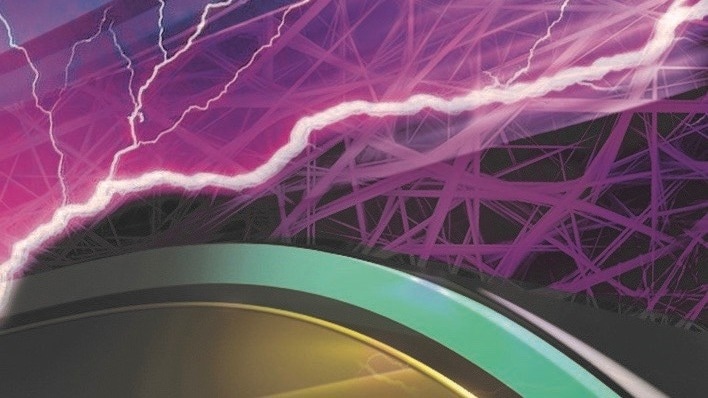Scientists develop a “best practice” protocol for researchers designing piezoelectric materials. This is the first of its kind in this advanced field of technology.

An artistic impression of electricity generation in a piezoelectric energy harvester made from piezoelectric nanofibers. Image Credit: Katharina Maisenbacher, Max Planck Institute for Polymer Research
A global team headed by physicists at University of Bath developed this protocol as a response to results that lack consistency in experimental reports. The scientists made the shocking exploration that 9 in 10 scientific papers lack experimental data, which is important to guarantee the reproducibility of the reported work.
In the journal Nano Energy, researchers talk about the immediate requirement for a standardized piezoelectricity research protocol.
Research into piezoelectricity has accelerated in recent years, and for good reason: piezoelectric materials generate electricity when you exert pressure or mechanical vibrations, or when you tap on or distort them. Add a circuit and this electricity can be stored and then used.
Dr. Morteza Hassanpour Amiri, Study First Author, Max Planck Institute for Polymer Research
High Energy-Harvesting Efficiency
As piezoelectrics have huge potential, for more than 20 years, a steady stream of new composites and materials have been designed and assessed for their energy harvesting capacity, with several of them claiming high efficiencies.
However, the scientists, headed by Professor Kamal Asadi from the Department of Physics, say these results—at times published in high-caliber journals—usually do not include the particulars of important experimental parameters. Such details are important to make sure of reproducibility when other study groups set out to independently evaluate or enhance the materials further.
Reproducibility of experimental research findings may not be the key to the success of a research, but it is the key to ruling out unreliable findings from being accepted as fact. The enthusiasm to develop a champion material that shows impressive performance should be accompanied with enough supporting data.
Professor Kamal Asadi, Study Lead Author, Department of Physics, University of Bath
The researchers from Bath tested 80 randomly chosen research papers published on piezoelectric energy harvesting devices for the past two decades. For approximately 90% of these papers, important experimental factors—required to test devices and materials—were lacking, hence rendering the experiments difficult, and at times impossible, to reproduce.
The Importance of Reproducibility
There are three important reasons why reproducibility is important: We are scientists and should strive to be as accurate as possible; we have limited resources, so by reporting all the necessary parameters that guarantee reproducibility, we are helping our peers to build up on our findings and advance the field; by being transparent, we also build trust with the public, and with science funding organizations and policymakers, and provide a better guidance for future ‘big’ decisions that can affect us all.
Professor Kamal Asadi, Study Lead Author, Department of Physics, University of Bath
Professor Asadi, a top expert in piezoelectricity, states this absence of data is hindering advancement in the field as scientists cannot look to the literature to find materials with the ideal harvesting potential.
New Protocol
Standardized data reporting and collection is recommended by the new Bath protocol. Prof. Chris Bowen from the Department of Mechanical Engineering at the University of Bath, who was also involved in this study, stated: “We have basically created guidelines that would be helpful to researchers in their field of piezoelectricity.”
Professor Asadi believes that, within the next ten years, electronic devices driven by piezoelectricity will be on the market.
“That’s why it’s important to have a standardized protocol for reporting research data for a quantitative evaluation of energy harvesting materials and devices. Doing so enables scientists to make real progress building on each other’s experiments and working towards a common goal: making piezoelectricity a reality for anyone hoping to charge their devices more sustainably and without reliance on a traditional power source.”
He added: “The field of piezoelectric energy harvesting is a really exciting field, it has lots of potential and great scientists are working on it, but it's still fledgling, and so to make sure we advance as well and as quickly as possible, ensuring experiments are reproducible is going to be crucial, so I hope our suggested protocol is adopted by the community at large.”
The paper named “Piezoelectric energy harvesters: A critical assessment and a standardized reporting of power-producing vibrational harvesters” describes this new protocol.
The University of Bath Physics undergraduates involved in this study were Rose Fatscher and Rebecca Taylor. The work was part of the Ph.D. thesis of Dr. Morteza Hassanpour Amiri and undertaken in association with Professor Paulo Rocha, from University of Coimbra, Portugal.
Journal Reference
Hassanpour Amiri, M. et al. (2023). Piezoelectric energy harvesters: A critical assessment and a standardized reporting of power-producing vibrational harvesters. Nano Energy. doi.org/10.1016/j.nanoen.2022.108073.